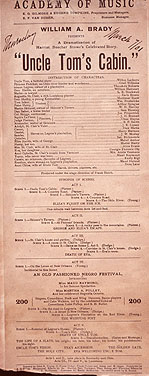
|
In March 1901 Wm. A. Brady, a well-known impresario, brought to the Academy of
Music his "$25,000 Revival" of Uncle Tom's Cabin. According to
contemporary reviews and reports, many of which you can read for yourself HERE, it was a spectacular success: one newspaper
article predicted 20,000 people would see it "each week it remains at the Academy." Brady's play relied heavily on the dramatization George L. Aiken wrote half a century earlier, though his script makes a number of revisions in Aiken's structure: it has 20 scenes instead of 30 (the most obvious cuts are Aiken's first two scenes and all the scenes with Gumption Cute, including the two at Ophelia's home in Vermont); it simplifies the drama's narrative by first following the Harrises north to freedom, then going south with Tom (rather than the parallel development these plot lines get in Stowe and Aiken); and as "Tom Shows" had been doing since the mid-1870s, it interpolates a series of musical and specialty numbers involving the company's "200" black performers. Perhaps most jarring of these is the scene of "general hilarity" involving Marks, his donkey and Legree's slaves at end of Act 5, immediately after Tom has been beaten for the first time. (You can see the AIKEN TEXT elsewhere in the archive; you can see a table comparing the two dramatizations by CLICKING HERE.) The electronic edition below of the Brady script has been prepared from the typed promptbook in The Museum of the City of New York. Typed in 1901 by "Z and L Rosenfield Stenography and Typewriting" company (office on Broadway), it differs in two significant ways from the first week's playbill you can see at left: (1) it divides the play into six acts rather than five (the auction scene stands alone as "Act IV"), and (2) the section of the last scene called "THE LIFE OF A SLAVE" (referred to as "a series of drops [curtains] representing various phases of slave life" in one review) has been eliminated. These changes, and the fact that the typed script allows for performative variations like "if dogs are used," suggests this 6-act version may have been prepared for the "tour of major cities" that the Brady company undertook after its two-month run in New York. This script also leaves much of the staging up to "Mr. [L. R.] Stockwell," the well-known actor who played "Marks, the lawyer." Stockwell's importance indicates how strongly this version emphasizes the comic elements in Stowe's story. Along that same line, it minimizes the abolitionist and Christian themes. The Brady production was photographed at least twice. Some of those pictures, showing the scenic grandeur of the show, can be seen here (below left); others are available on the TOM SHOW PHOTOS PAGE. The script is available, act by act or scene by scene, below. Only the typed script is reproduced here, not the many notes and revisions made by at least two different stage managers. |
CLICK TO ENLARGE 




 CLICK TO ENLARGE |
|
